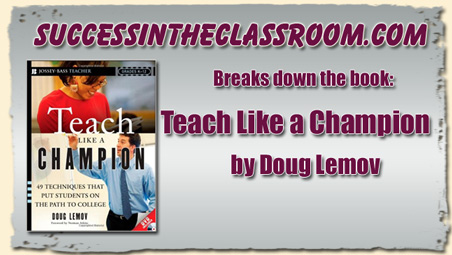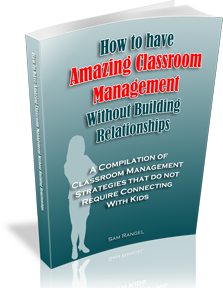
Hello again,
As I stated in my previous post, I’m no longer a classroom teacher. I’m working at a new school in administration. When I met my new principal, he gave me a book that he wants the staff to embrace as part of his vision to prepare the students for college.
It’s called, Teach Like a Champion – 49 Techniques that Put Students on the Path to College by Doug Lemov.
I started reading it, and found that the techniques mentioned in the book are very good. I found that I had already been incorporating some of them in my lessons without even knowing. Others mentioned in the book made me want to jump back into the classroom just to try them out.
It may be too late for me, but I’d like to share some of these techniques here on SITC so that new teachers can be able to use these techniques in their own classrooms.
I doubt I’ll be able to mention all 49 techniques, so I’ll highlight the ones I saw as especially noteworthy.
Here’s the first technique: No Opt Out
How many times have you asked a student a question only to get the blank stare in response?
A lot of times, we give the student a break, and move on to another student. We don’t want to embarrass the student in front of the class. I’ve done this.
The idea of this technique, however, is to not let the student off the hook when you ask him/her a question. He/She can’t opt out of answering the question.
Many times a student will not be able or not be willing to answer a question. They’ll say, “I don’t know,” and expect you to move on to someone else.
This technique ends with the student responding with the correct answer.
How do you do this?
One strategy you can use is to ask another student to answer the question. Then, return to the original student, and ask the question again.
The point is to make sure the original student completes the cycle by responding with the correct answer.
According to the book, “…the technique allows you to ensure that all students take responsibility for learning. It establishes a tone of student accountability, and it honors and validates students who do know the answer by allowing them to help their peers in a positive and public way.”
I think you have to be careful that you don’t humiliate the student. I wouldn’t spend too much time getting the student to answer. I wouldn’t even make a big deal about a correct answer. I would say, “Good job,” and move on to the next question.
The student, however, cannot be given the option of NOT answering the question.
I like this technique, because eventually every student in the classroom will know that in your classroom, they will be held accountable.
That is good practice for college.
What do you think? Too stressful on the student?
Let me know.
Thanks,
Sam




I used this technique often in teaching my special ed students. Too many times they would not do an assignment and then tell me, “Just give me a zero.” I would tell them that it wasn’t an option. They could either do the work on time and get a grade they earned or they would not be allowed to move forward until they turned in the assignment late and get 20 points taken off. But not doing the assignment was not an option. Once they saw that I would stick by this rule, they learned quickly and I didn’t have too much trouble getting them to do their work. In fact, I think it helped them be more successful in the long run because they couldn’t avoid the work they didn’t want to do.
Thanks Pat.
I used to think that letting my students off the hook was nice of me, but then I realized that I wasn’t doing them any favors. I can see how students with special needs would take advantage of this, expecting to not have to participate because of their disability. I like how you didn’t buy into that.
I’m really liking this book, mainly because I find myself saying, “I used to do that!” a lot.
Thanks again Pat,
Sam